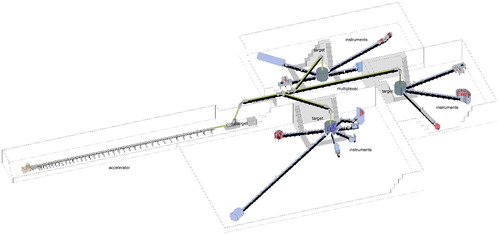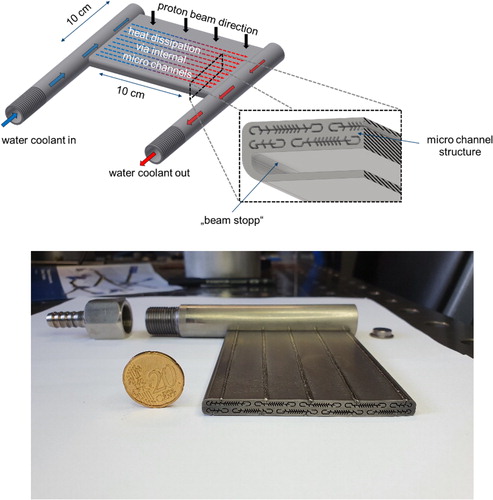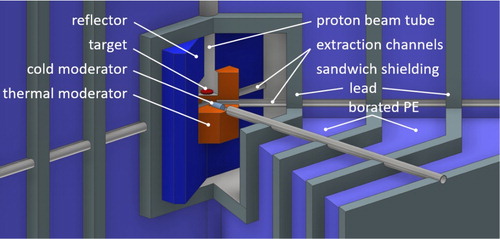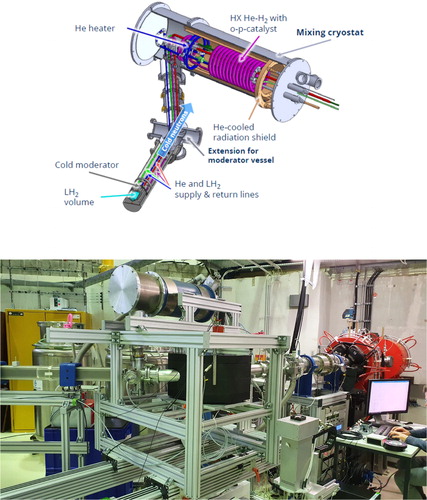Introduction
Neutrons are an essential tool in science and research for probing the structure and dynamics of matter from the mesoscale to the picoscale and from seconds to femtoseconds.
To release neutrons for research, the commonly used methods are fission in nuclear reactors, spallation using high-power proton accelerators, and nuclear reactions with low-energy proton accelerators. The first two techniques have been used very successfully in Europe for decades and offer the highest neutron flux with a broad range of applications. More than 8000 users utilize the available neutron sources in Europe, requesting nearly twice the available capacity offered per year.
With the high demand for neutron experiments by science and industry and the phasing out of existing reactor-based neutron facilities in Europe in recent years, new solutions and strategies are discussed to provide and secure a sustainable and effective access to neutrons in Europe. In particular, cost-effective solutions are required to compensate the potential loss in capacity and access and to complement high-flux sources such as the new ESS spallation neutron source currently in construction.
Responding to this situation, the Jülich Centre for Neutron Science (JCNS) has an ongoing project towards the development and design of compact accelerator driven high brilliance neutron sources using nuclear reactions with low energy protons as an efficient and cost-effective alternative to current low and medium flux reactor and spallation sources [Citation1].
The project is to deliver a High Brilliance neutron Source (HBS), where a compact neutron production system and a compact moderator system produce a field of thermal and cold neutrons with high brilliance which can efficiently be extracted into an optimized neutron transport system.
By shaping the experiment from the source to the instrument detector, the goal is to design the neutron instrument to fulfil the different scientific requirements in a flexible and efficient way at demand by the neutron user. HBS will realize a novel type of neutron facility on the basis of flexible compact accelerators with dedicated target and moderator solutions for specific experimental requirements.
Characteristics and development of Jülich HBS
The Jülich High Brilliance neutron Source presents a novel concept for a compact accelerator driven neutron source closing the gap between laboratory oriented small-scale neutron sources as neutron generators or low power (<1 kW) accelerator-based sources and high flux reactor based or spallation neutron sources.
The baseline specification for the HBS is an accelerator driven compact neutron source serving up to three individual target stations of 100 kW power each with initially up to six independent beamlines at each target station ().
Nuclear reaction and target for primary neutron generation
The neutron production at an accelerator driven compact neutron source is based on nuclear reactions in a suitable target material initiated by impinging ions with energies in the MeV range. The energy is below the threshold of spallation reactions (<100 MeV) but above the threshold for a nuclear reaction to produce neutrons. As the ions are decelerated when traveling through the target material, their energy decreases and the corresponding cross section for neutron production changes. The neutron yield for a specific target material therefore depends on the neutron production cross section, the stopping power of the target material and the target thickness.
With increasing proton energy, the neutron yield increases. At low energies below 10 MeV, lithium and beryllium, which are commonly used as target materials, produce a high number of neutrons for proton induced reactions whereas all other elements have a lower neutron yield. At intermediate energies around 10 MeV, the elements with atomic numbers between 20 and 40 form a transition region in terms of total neutron yield. Above ∼ 30 MeV energy, the heavy elements exhibit a high neutron yield without much variation from element to element () [Citation2].
Figure 2. Neutron yield for various target materials [Citation5].
![Figure 2. Neutron yield for various target materials [Citation5].](/cms/asset/e8a1311c-d5d6-4252-bcea-54898e75b284/gnnw_a_1819132_f0002_c.jpg)
In order to reach a most attractive neutron yield in the Jülich High Brilliance neutron Source operated at 70 MeV, a tantalum target was chosen. Tantalum has a high neutron yield, can be manufactured well, has good thermo-mechanical properties and a high blistering threshold.
Accelerator
The HBS belongs to the class of low energy compact accelerator-based neutron sources (CANS). Here, the term “compact” must be seen in comparison with spallation sources, which due to their use of high energy proton beams of several 100 MeV, typically require massive shielding and high power target cooling infrastructure.
In the case of HBS, the accelerator must provide a proton beam of 100 mA and an energy of 70 MeV [Citation3]. The proton beam will be extracted from a hydrogen plasma, which will be ignited in the plasma generator of the proton source. An Electron Cyclotron Resonance (ECR) ion source is one of the most favorable type using a Radio Frequency (RF)-driven gas discharge.
The accelerator has to provide a pulsed proton beam for at least three target stations with an average beam power of 100 kW each resulting in a total average beam power of 300 kW and a total duty cycle of ∼4.3% (). With these parameters a normal conducting accelerator is the preferable choice. Similar accelerators already exist, like the Linac-4/SPL, the FAIR-p-Linac, the ESS or the SNS accelerators. The advantages of the room temperature (RT), normal conducting, linear accelerator are easy access, a simpler and available technology, lower investment costs and higher reliability.
Table 1. Accelerator parameters used in the HBS Project.
To achieve the final beam energy of 70 MeV, the HBS Linac consists of a front end (ECR source), low energy beam transfer (LEBT, 2.5 MeV double radio frequency quadrupole [RFQ]) and a drift tube linac (DTL) with 35 room temperature H-mode type cavities. All RF structures are operated at 176.1 MHz and are designed for high duty cycle.
The beam is sent to three different targets by means of a multiplexer in the high energy beam transfer (HEBT) [Citation4]. Hereby, a geometric request to the deflection angle from the particle orbit comes from the dynamics of the ion beam in the setup. A kicker magnet and septum magnet combination will be employed. The fast kicker magnet introduces a 20 mrad kick angle onto the beam-trajectory. After a well-defined separation of the beam from the straight directory, a 125 mT·m dc magnet takes over, further deflecting the beam towards the target.
Each individual beam behind the multiplexer will have a specific time structure in order to use the optimum resolution of the different instruments grouped around the specific target. The macro pulse lengths result from the experimental requirements and were fixed at 52 μs (384 Hz), 208 μs (96 Hz) and 833 μs (24 Hz). Note that the proton beam is fed from above into the target stations (see ) thus leaving maximum space for horizontal beamlines.
Target
The neutrons are released by nuclear reaction in a suitable target material. For energies above 50 MeV, high Z materials are preferable regarding the neutron yield. The target design depends on the power it has to withstand, the type and energy of the primary particle and the target material.
For the target design of HBS at a power level of 100 kW, tantalum as target material has been chosen [Citation5]. The power density deposition with a target area of 100 cm2 is 1 kW/cm2. Such a target cannot be cooled by conventional water cooling. We propose to use at this position μ-channels, which can remove up to 3.5 kW/cm2[6]. With a complex fin-like μ-channel structure (), it is possible to remove the heat very efficiently and achieve temperatures inside the target which are below 100 °C and a temperature induced stress of around 80 MPa well below the yield strength of tantalum (300 MPa) as calculated using the ANSYS toolkit.
Moderator-reflector system
The target/moderator/shielding assembly consists of the target, which is surrounded by a thermal moderator like polyethylene (PE), slowing down the fast neutrons with MeV energy to thermal energies between 10 meV and 500 meV. A reflector made from beryllium, lead or graphite increases the thermal neutron flux inside the moderator due to backscattering. Everything is surrounded by the shielding consisting of borated PE and lead () [Citation2]. Extraction channels directing the thermalized neutrons to the instruments are inserted into this assembly. Their location is optimized in such a way that they extract the neutrons from the maximum of the thermal neutron flux inside the moderator. Into these extraction channels cryogenic one-dimensional finger moderators can be inserted, further shifting the thermalized neutron spectrum to cold neutron energies between 1 meV and 10 meV.
Cold moderators
Cold moderators decrease the neutron energy spectrum below the thermal spectrum by moderating the neutrons in a suitable moderator material at cryogenic temperatures. In reactor based or spallation neutron sources, typically one single cold moderator is installed, which is designed to provide one specific neutron spectrum, but feeds several instruments that may have different spectral requirements. The HBS changes that “one-size-fits-all” paradigm and instead supplies every instrument with cold neutrons from its own adapted cold neutron source. In this sense, the cold moderator becomes an intrinsic part of the instrument and can be optimized individually during the process of instrument design.
To provide a high density of cold neutrons, a moderator material is needed that interacts strongly with thermal neutrons within a small volume. Suitable materials are e.g. liquid hydrogen H2, solid methane CH4 or solid mesitylene C9H12. Particularly well-suited for a one-dimensional cold moderator is para-hydrogen. For neutron energies below 20 meV (i.e. wavelengths above 2 Å), the scattering cross section is more than one order of magnitude lower than for thermal neutrons. This results in a mean free path for thermal neutrons of about 1 cm, compared to a mean free path for cold neutrons of some 10 cm.
Based on these specific properties, a one-dimensional cold finger moderator has been developed () [Citation7]. The name refers to a design which is comprised of a long vacuum tube with a small cryogenic moderator vessel (e.g. cylindrical with 10 cm in length and 2 cm in diameter) at one end and with thermal vacuum isolation surrounding it. This design enables the installation of the cold moderator inside the thermal moderator through a single extraction channel without the need for dismantling the shielding or reflector. Full flexibility towards future developments in the field of cold moderators is achieved with this approach. By positioning the cryogenic moderator inside the thermal flux maximum, it is fed optimally with thermal neutrons through the entire side surface without depletion in the center. The cold neutrons can be emitted freely towards the instrument through the extraction channel with a view onto the entire volume of the cylinder, as the length of the cylinder does not exceed the mean free path for cold neutrons. In the prototype design of the cold finger moderator, all supply lines (e.g. cryogenic supply) and wires (e.g. measurement and control) are located inside the vacuum tube but outside of the cold neutron flight path at the center of the tube [Citation8].
Neutron beam transport
Up to six beamlines for six terminal instruments can be supplied with neutrons from one target station (). The neutrons are extracted horizontally at the level of the target via extraction channels. The extraction channels begin inside the thermal moderator close to the position of the highest thermal neutron flux. Every extraction channel is adapted in geometry and position to extract the neutron phase space that is best adapted to the requirements of the instrument attached there.
Figure 6. Possible positioning of up to six extraction channels within the thermal moderator close to the target. Here an arrangement with the proton beam hitting the target from aside is shown.
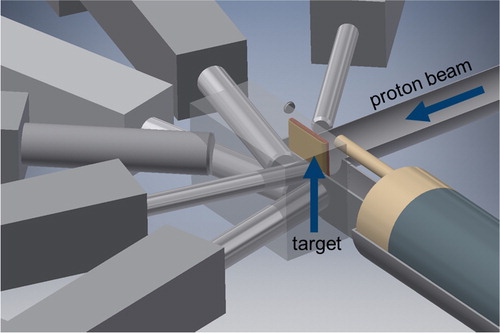
Appropriate neutron guide systems will be added e.g. with elliptical neutron guides with a high m coating close to source and sample to enable high guide transmission and high divergence at the sample when needed.
Instrumentation
The instruments built at a pulsed CANS are designed in a time-of-flight (ToF) setup and can be mainly distinguished by the bandwidth they can use and the resolution they need. The bandwidth and the resolution can be defined by choppers, which could result in a loss in neutron flux at the sample position. A more efficient approach is to match the repetition rate of the neutron beam to the instrument length in such a way that the maximal useful phase space volume is filled. For a large-scale facility as HBS, we distinguish at least three different repetition rates of about 24 Hz, 96 Hz and 384 Hz. Instruments using these repetition rates are grouped together around the same target station [Citation2].
For example, at the highest repetition rate of 384 Hz, secondary spectrometers for inelastic neutron scattering experiments with a short length will be built. As the flight path is short, the phase space volume can be filled with a high repetition rate so that the flux is maximized. The target station with the intermediate repetition rate of 96 Hz will provide neutrons for high resolution diffractometers with a larger bandwidth. At the low repetition rate of 24 Hz, instruments with a large bandwidth of cold neutrons with a relaxed resolution will be built like a reflectometer or small angle neutron scattering (SANS) so that these instruments have no resolution degradation with long pulses.
Analytic instruments like a prompt and delayed gamma neutron activation analysis (PDGNAA), neutron depth profiling (NDP), or an imaging station will be built at the target station with the low or intermediate repetition rate. The resulting resolution can resolve Bragg-edges for the imaging experiment and the PDGNAA can be operated in ToF-mode giving depth resolved information.
Potential neutron fluxes for some basic instruments at HBS with three different target stations and adjusted proton pulse frequencies are given in .
Table 2. Analytically calculated instrument parameters for HBS
Outlook
The Jülich High Brilliance neutron Source presents a novel concept for a compact accelerator driven neutron source closing the gap between laboratory-oriented small scale neutron sources, such as neutron generators or low power (<1 kW) accelerator based sources, and high flux reactor based or spallation neutron sources. The project has evolved within the last few years through technical studies, nuclear simulations and experiments performed at the Jülich Centre for Neutron Science (JCNS) at Forschungszentrum Jülich.
The aim of the HBS project is to develop and realize a versatile and cost-efficient accelerator driven neutron source. A conceptual design report has been written and published with a detailed description and overview of the project and all relevant parts [Citation9]. As many different technological challenges are present in the HBS project, ranging from accelerator system, neutron targets, moderators up to the instruments, each component has to be investigated and optimized individually. In upcoming years, a dedicated technical design report will be prepared. It is planned to develop and construct a prototype facility to prove the feasibility of the concept and to demonstrate that a full-fledged facility can be constructed to secure sustainable access to neutrons in Germany and beyond within the next decades.
HBS will place research with neutrons on a new broad basis. It will open up and spread neutron science to include industry in its broadest sense and will enhance competitiveness in basic and applied research using neutron facilities. The new accelerator-based neutron source HBS will complement and further develop the research landscape of high-end neutron facilities in Europe. In addition, HBS will provide training and preparation for high-level experiments at flagship European neutron sources such as the ILL or ESS in the future.
References
- T. Gutberlet, U. Rücker, P. Zakalek, T. Cronert, J. Voigt, J. Baggemann, P.-E. Doege, E. Mauerhofer, S. Böhm, J.P. Dabruck, R. Nabbi, M. Butzek, M. Klaus, C. Lange, and T. Brückel, Physica B: Condensed Matter, 570, 345–348 (2019).
- P. Zakalek, P. Zakalek, T. Cronert, J. Baggemann, P.-E. Doege, M. Rimmler, J. Voigt, E. Mauerhofer, U. Rücker, T. Gutberlet , T. Brückel, H. Podlech, O. Meusel, M. Schwarz, J. Li, and S. Böhm, Proc. HIAT’18, Lanzhou, China, 117–121 (2018).
- H. Podlech, J. Baggemann, S. Böhm, T. Brückel, T. Cronert, P.E. Doege, M. Droba, T. Gutberlet, K. Kümpel, S. Lamprecht, E. Mauerhofer, O. Meusel, N. Petry, U. Rücker, P. Schneider, M. Schwarz, J. Zakalek, and C. Zhang, Proc. IPAC’19, Melbourne, Australia, 910–913 (2019).
- M. Rimmler, J. Baggemann, P. Doege, O. Felden, E. Mauerhofer, U. Rücker, H. Soltner, P. Zakalek, R. Gebel, T. Gutberlet, and T. Brückel, EPJ Web Conf., 231, 02002 (2020).
- P. Zakalek, P.-E. Doege, J. Baggemann, E. Mauerhofer, and T. Brückel, EPJ Web Conf., 231, 03006 (2020).
- P. Mastinu, G. Martın-Hernandez, J. Praena, F. Gramegna, G. Prete, P. Agostini, A. Aiello, and B. Phoenix, Il Nuovo Cimento, 38C, 193 (2015).
- T. Cronert, J.P. Dabruck, P.E. Doege, Y. Bessler, M. Klaus, M. Hofmann, P. Zakalek, U. Rücker, C. Lange, M. Butzek, W. Hansen, R. Nabbi, and T. Brückel, J. Phys. Conf. Ser., 746, 012036 (2016).
- S. Eisenhut, M. Klaus, J. Baggemann, U. Rücker, Y. Beßler, A. Schwab, C. Haberstroh, T. Cronert, T. Gutberlet, T. Brückel, and C. Lange, EPJ Web of Conf., 231, 04001 (2020).
- https://www.fz-juelich.de/jcns/jcns-2/EN/Forschung/High-Brilliance-Neutron-Source/

